Experimental Study Demonstrating a Cost-Effective Approach for Generating 3D-Enhanced Models of Sediment Flushing Cones Using Model-Based SFM Photogrammetry
Abstract
1. Introduction
2. Materials and Methods
2.1. Structure from Motion
2.2. Photogrammetry Software for 3D Model Generation
2.3. Model Control Points (MCPs) and Georeferencing
2.4. SFM Method Limitations in the Laboratory Condition
2.5. Methodology
2.5.1. Laboratory Model
2.5.2. Experimental Application/Impact of Different Shapes of Extended Dendritic Channels
2.5.3. Flushing Processes
2.5.4. Efficiency
2.5.5. Surveying of Sediment Flushing Cone Geometry (SFCG)
3. Results
3.1. Cube Box Test
3.2. Data Acquisition and Georeferencing
3.3. Processing and Post-Processing
3.4. Investigation of the Surveyed Data Accuracy of Sediment Flushing Cone Dimensions with the SFM Method
3.5. Investigation of the Surveyed Data Accuracy of Sediment Flushing Cone Cross-Section with the SFM Method
3.6. Investigation of the Accuracy of the Surveyed Data for the Temporal Development of the Sediment Flushing Cone with the SFM Method
4. Discussion
4.1. Evaluation of the SFM Method Performance
4.2. Evaluation of the Data Accuracy of the Current SFM Method
4.3. Data Accuracy of the Current SFM Method Compared with Other SFM Methods
5. Conclusions
Author Contributions
Funding
Institutional Review Board Statement
Informed Consent Statement
Data Availability Statement
Acknowledgments
Conflicts of Interest
Notations
| BA | Bundle adjustment |
| DC | Depth of the sediment flushing cone (m) |
| Do | Diameter of the bottom outlet (m) |
| DBE | Dendritic bottomless extended structure |
| DDBE | Diameter of the DBE structure (m) |
| DEM | Digital elevation model |
| GCPs | Ground control points |
| GIS | Geographic information system |
| Length of the sediment flushing cone (m) | |
| Length of the branches of the DBE structure (m) | |
| MCPs | Model control points |
| Outlet discharge (m3/s) | |
| Coefficient of determination of the prediction equations | |
| RMSE | Root mean square error |
| Standard error lines representing the average distance the observed values fall from the regression line | |
| SFM | Structure from motion |
| SFCG | Sediment flushing cone geometry |
| SIFT | Scale-invariant feature transform |
| T | Time elapsed since the beginning of the experiment (min) |
| Time duration of scour equilibrium (min) | |
| TIN | Triangular irregular network |
| Width of the sediment flushing cone (m) |
References
- Esmaeili, T.; Sumi, T.; Kantoush, S.A.; Kubota, Y.; Haun, S.; Rüther, N. Numerical Study of Discharge Adjustment Effects on Reservoir Morphodynamics and Flushing Efficiency: An Outlook for the Unazuki Reservoir, Japan. Water 2021, 13, 1624. [Google Scholar] [CrossRef]
- Haghjouei, H.; Rahimpour, M.; Qaderia, K.; Kantoush, S.A. Experimental study on the effect of bottomless structure in front of a bottom outlet on a sediment flushing cone. Int. J. Sediment Res. 2021, 36, 335–347. [Google Scholar] [CrossRef]
- Isaac, N.; Eldho, T.I. Sediment removal from run-of-the-river hydropower reservoirs by hydraulic flushing. Int. J. River Basin Manag. 2019, 17, 389–402. [Google Scholar] [CrossRef]
- Meshkati, M.E.; Dehghani, A.A.; Naser, G.; Emamgholizadeh, S.; Mosaedi, A. Evolution of developing flushing cone during the pressurized flushing in reservoir storage. World Acad. Sci. Eng. Technol. 2009, 3, 10–27. [Google Scholar] [CrossRef]
- Beiramipour, S.; Qaderi, K.; Rahimpour, M.; Ahmadi, M.M.; Kantoush, S.A. Effect of submerged vanes in front of a circular reservoir intake on sediment flushing cone. Water Manag. 2021, 174, 252–266. [Google Scholar] [CrossRef]
- Ahadpour Dodaran, A.; Park, S.K.; Mardashti, A.; Noshadi, M. Investigation of dimension changes in under pressure hydraulic sediment flushing cavity of storage dams under effect of localized vibrations in sediment layers. Ocean Syst. Eng. 2012, 2, 71–81. [Google Scholar] [CrossRef][Green Version]
- Shahirnia, M.; Ayyoubzadeh, S.; Mohamad Vali Samani, J. Investigation on the effect of sediment level on pressurized flushing performance from reservoirs using physical model. J. Hydrol. 2014, 9, 11–25. (In Persian) [Google Scholar]
- Emamgholizadeh, S.; Fathi-Moghadam, M. Pressure flushing of cohesive sediment in large dam reservoirs. J. Hydraul. Eng. 2014, 19, 674–681. [Google Scholar] [CrossRef]
- Madadi, M.R.; Rahimpour, M.; Qaderi, K. Improving the pressurized flushing efficiency in reservoirs: An experimental study. Water Resour. Manag. 2017, 31, 4633–4647. [Google Scholar] [CrossRef]
- Dreyer, S. Investigating the Influence of Low-Level Outlet Shape on the Scour Cone Formed during Pressure Flushing of Sediments in Hydropower Plant Reservoirs. Master’s Thesis, University of Stellenbosch, Stellenbosch, South Africa, 2018. [Google Scholar]
- Ruther, N. Structure from Motion Applied to Movable Bed Scale Models. Master’s Thesis, Norwegian University of Science and Technology, Trondheim, Norway, 2019. [Google Scholar]
- Fonstad, M.A.; Dietrich, J.T.; Courville, B.C.; Jensen, J.L.; Carbonneau, P.E. Topographic structure from motion: A new development in photogrammetric measurement. Earth Surf. Process. Landf. 2013, 38, 421–430. [Google Scholar] [CrossRef]
- James, M.R.; Robson, S. Straightforward reconstruction of 3D surfaces and topography with a camera: Accuracy and geoscience application. J. Geophys. Res. Earth Surf. 2012, 117, F03017. [Google Scholar] [CrossRef]
- Micheletti, N.; Chandler, J.H.; Lane, S.N. Geomorphological Techniques. In Structure from Motion (SFM) Photogrammetry; Online Edition; British Society for Geomorphology: London, UK, 2014; Chapter 2, Section 2.2; ISSN 2047-0371. [Google Scholar]
- Westoby, M.J.; Brasington, J.; Glasser, N.F.; Hambrey, M.J.; Reynolds, J.M. ‘Structure-from-Motion’ photogrammetry: A low-cost, effective tool for geoscience applications. Geomorphology 2012, 179, 300–314. [Google Scholar] [CrossRef]
- Nyimbili, P.H.; Demirel, H.; Seker, D.Z.; Erden, T. Structure from Motion (SfM)—Approaches and Applications. In Proceedings of the International Scientific Conference on Applied Sciences, Antalya, Turkey, 27–30 September 2016. [Google Scholar]
- Javernick, L.; Brasington, J.; Caruso, B.S. Modeling the topography of shallow braided rivers using Structure-from-Motion photogrammetry. Geomorphology 2014, 213, 166–182. [Google Scholar] [CrossRef]
- Ullman, S. The Interpretation of Structure from Motion. Proc. R. Lond. Soc. B 1979, 203, 405–426. [Google Scholar]
- Holata, L.; Plzák, J.; Světlík, R.; Fonte, J. Integration of Low-Resolution ALS and Ground-Based SfM Photogrammetry Data. A Cost-Effective Approach Providing an ‘Enhanced 3D Model’ of the Hound Tor Archaeological Landscapes (Dartmoor, South-West England). Remote Sens. 2018, 10, 1357. [Google Scholar] [CrossRef]
- Bomminayun, S.; Stoesser, T. Turbulence Statistics in an Open-Channel Flow over a Rough Bed. J. Hydraul. Eng. 2011, 137, 1347–1358. [Google Scholar] [CrossRef]
- Dietrich, J.T. Applications of Structure-from-Motion Photogrammetry to Fluvial Geomorphology. Ph.D. Thesis, University of Oregon, Eugene, OR, USA, 2014. [Google Scholar]
- Smith, M.W.; Carrivick, J.L.; Hooke, J.; Kirkby, M.J. Reconstructing flash flood magnitudes using “Structure-from-Motion”: A rapid assessment tool. J. Hydrol. 2014, 519, 1914–1927. [Google Scholar] [CrossRef]
- Kasprak, A.; Wheaton, J.; Ashmore, P.; Hensleigh, J.; Peirce, S. The relationship between particle travel distance and channel morphology: Results from physical models of braided rivers. J. Geophys. Res. Earth Surf. 2014, 120, 55–74. [Google Scholar] [CrossRef]
- Thumser, P.; Kuzovlev, V.; Zhenikov, K.; Zhenikov, Y.; Boschi, M.; Boschi, P.; Schletterer, M. Using structure from motion (SFM) technique for the characterization of riverine systems—Case study in the headwaters of the Volga River. Geogr. Environ. Sustain. 2017, 10, 31–43. [Google Scholar] [CrossRef][Green Version]
- Ferreira, E.; Chandler, J.; Wackrow, R.; Shiono, K. Automated extraction of free surface topography using SfM-MVS photogrammetry. Flow Meas. Instrum. 2017, 54, 243–249. [Google Scholar] [CrossRef]
- Duró, G.; Crosato, A.; Kleinhans, M.; Uijttewaal, W. Bank erosion processes measured with UAV-SfM along complex banklines of a straight mid-sized river reach. Earth Surf. Dyn. 2018, 6, 933–953. [Google Scholar] [CrossRef]
- Masoudi, A.; Noorzad, A.; Majdzadeh Tabatabai, M.R.; Samadi, A. Application of short-range photogrammetry for monitoring seepage erosion of riverbank by laboratory experiments. J. Hydrol. 2018, 558, 380–391. [Google Scholar] [CrossRef]
- Naves, J.; Anta, J.; Puertas, J.; Regueiro-Picallo, M.; Suárez, J. Using a 2D shallow water model to assess Large-scale Particle Image Velocimetry (LSPIV) and Structure from Motion (SfM) techniques in a street-scale urban drainage physical model. J. Hydrol. 2019, 575, 54–65. [Google Scholar] [CrossRef]
- Zamani, P.; Mohajeri, H.; Samadi, A. Application of Structure from Motion (SFM) Method to Determine the Bed Surface Particles Sizes in Gravel Bed Rivers. Iran J. Soil Water Res. 2019, 50, 215–230. [Google Scholar] [CrossRef]
- Šiljeg, A.; Marić, I.; Cukrov, N.; Domazetović, F.; Roland, V. A Multiscale Framework for Sustainable Management of Tufa-Forming Watercourses: A Case Study of National Park “Krka”, Croatia. Water 2020, 12, 3096. [Google Scholar] [CrossRef]
- Spreitzer, G.; Tunnicliffe, J.; Freidrich, H. Large wood (LW) 3D accumulation mapping and assessment using structure from Motion photogrammetry in the laboratory. J. Hydrol. 2020, 581, 124430. [Google Scholar] [CrossRef]
- Snavely, N.; Seitz, S.M.; Szeliski, R. Modeling the World from Internet Photo Collections. Int. J. Comput. Vis. 2008, 80, 189–210. [Google Scholar] [CrossRef]
- Furukawa, Y.; Ponce, J. Accurate, dense, and robust multi-view stereopsis. In Proceedings of the IEEE Conference on Computer Vision and Pattern Recognition (CVPR), Minneapolis, MN, USA, 17–22 June 2007. [Google Scholar]
- Agisoft Metashape Version 1.8: User Manual: Professional Edition. 2022. Available online: https://www.agisoft.com/pdf/metashape-pro_1_8_en.pdf (accessed on 12 March 2022).
- De Reu, J.; De Smedt, P.; Herremans, D.; Van Meirvenne, M.; Laloo, P.; De Clercq, W. On introducing an image-based 3D reconstruction method in archaeological excavation practice. J. Archaeol. Sci. 2014, 41, 251–262. [Google Scholar] [CrossRef]
- Beiramipour, S.; Qaderi, K.; Rahimpour, M.; Ahmadi, M.M.; Kantoush, S.A. Investigation of the Impacts of Submerged Vanes on Pressurized Flushing in Reservoirs. Iran J. Soil Water Res. 2020, 51, 2187–2201. (In Persian) [Google Scholar]
- Haghjouei, H.; Rahimpour, M.; Qaderia, K.; Kantoush, S.A. Experimental Investigation of Temporal Development of the Sediment Flushing Cone in Reservoirs Affected by DBE Structure. Iran J. Soil Water Res. 2020, 51, 2221–2233. (In Persian) [Google Scholar] [CrossRef]

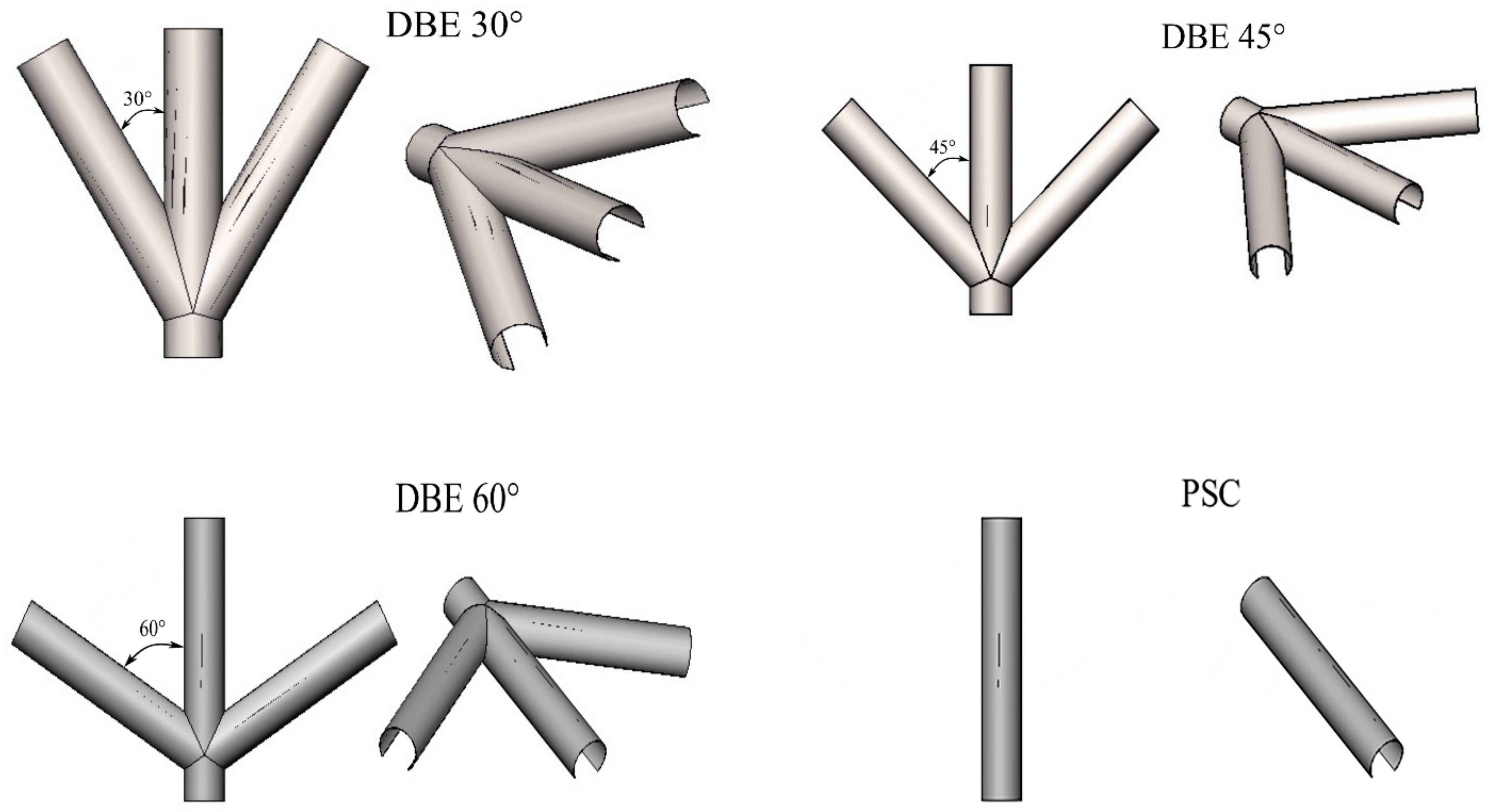
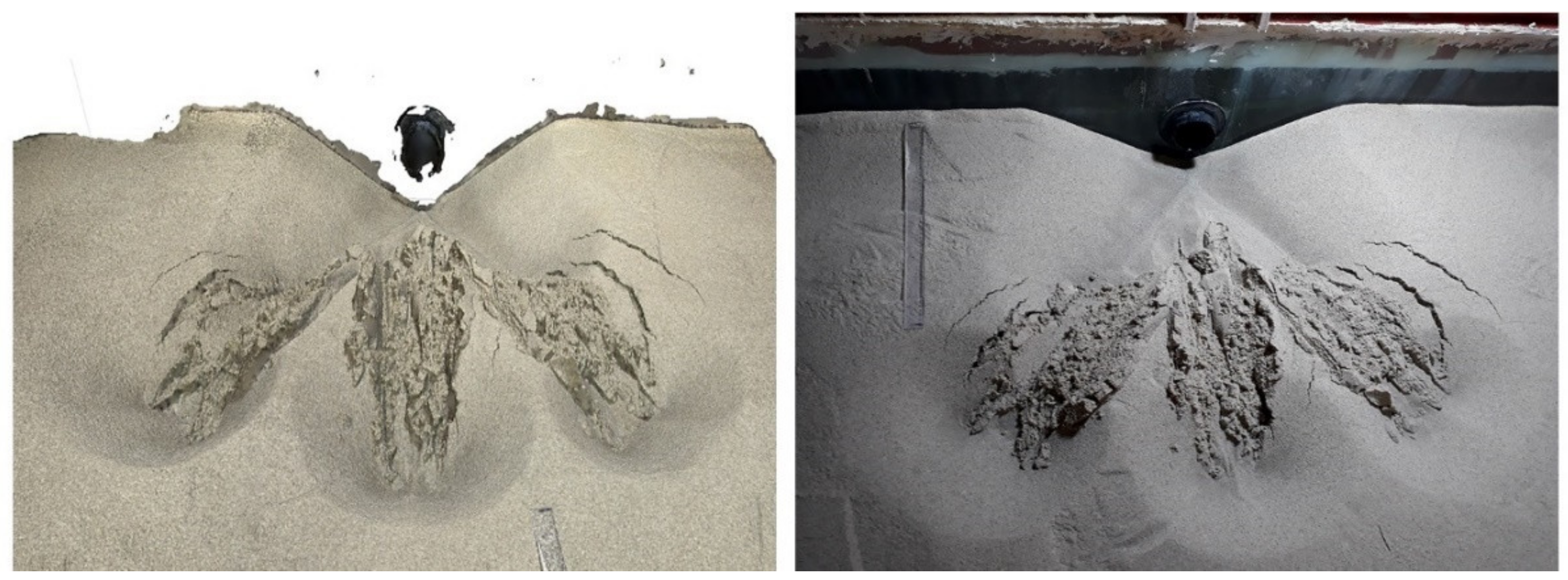
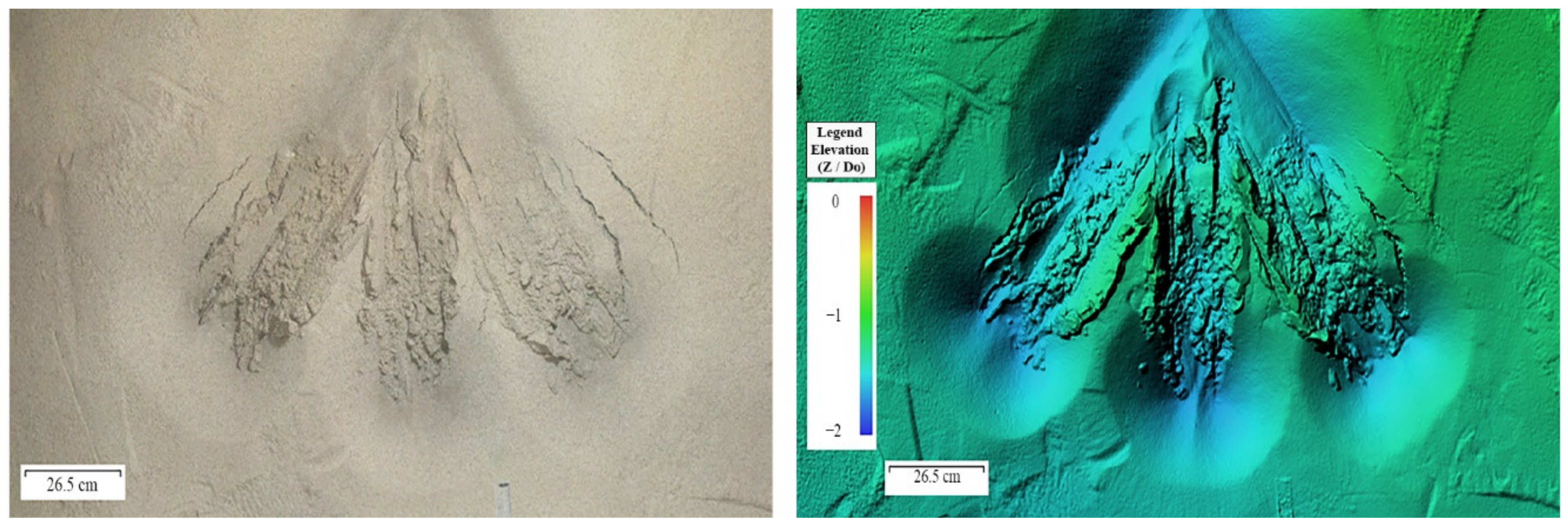
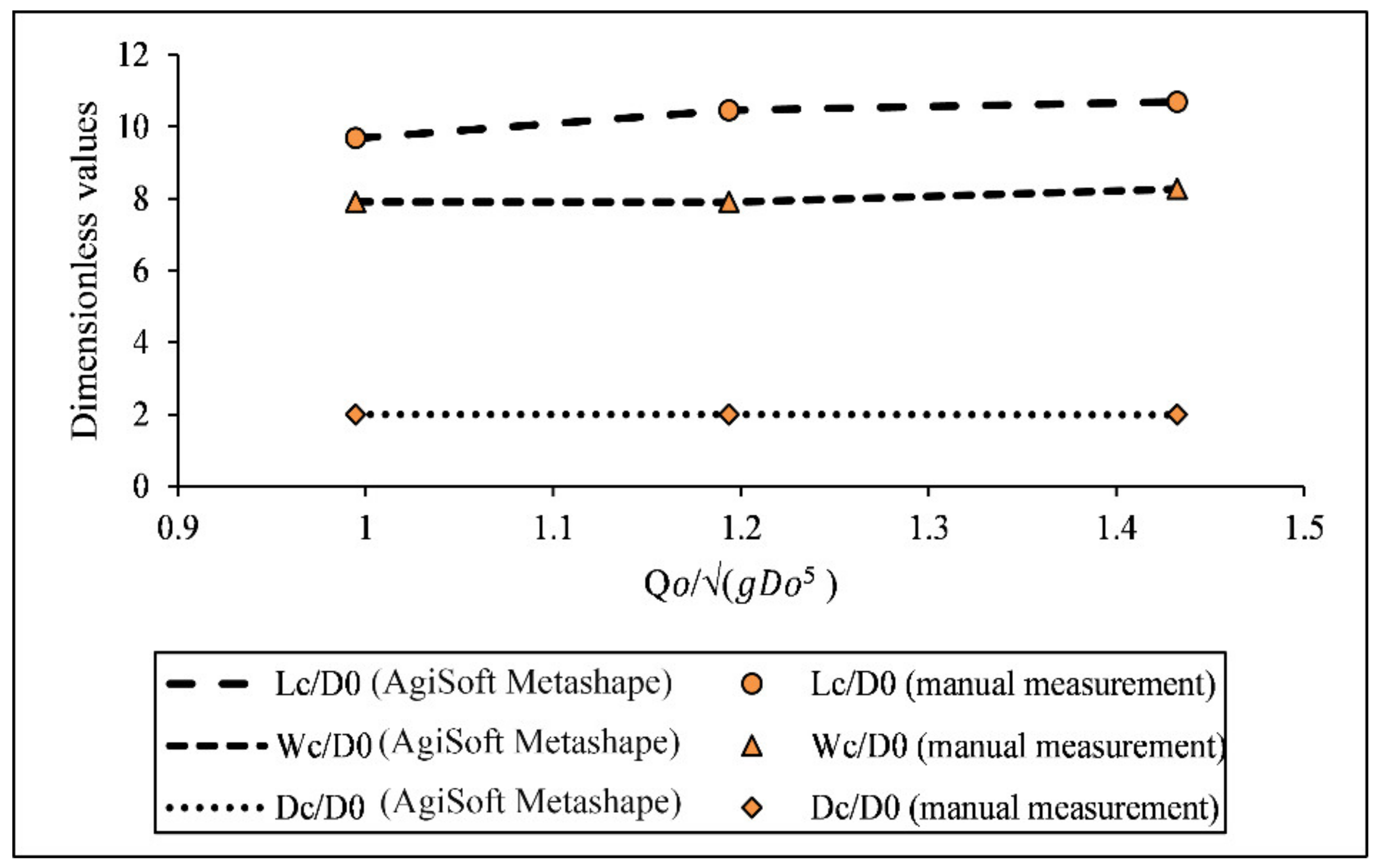
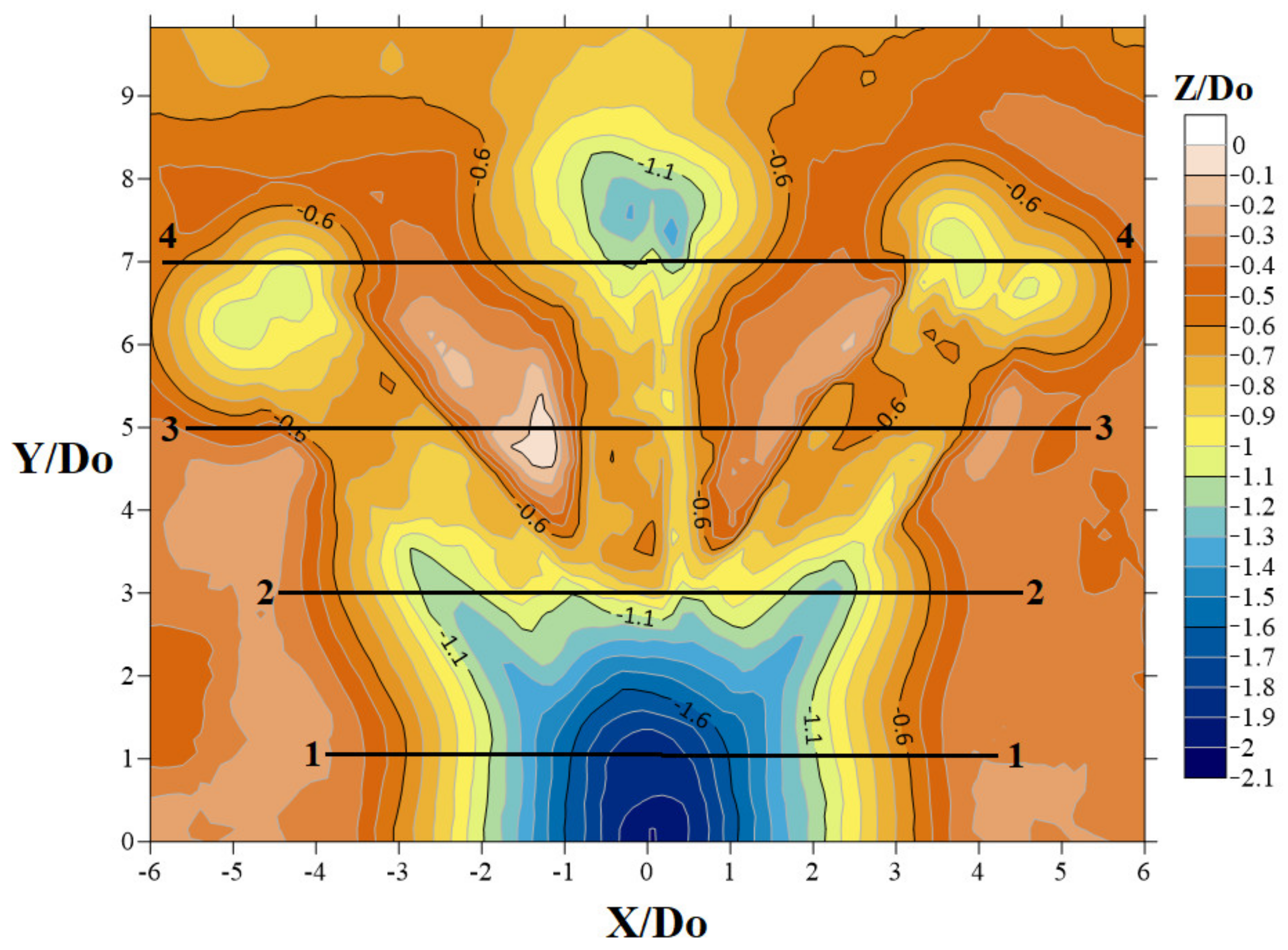

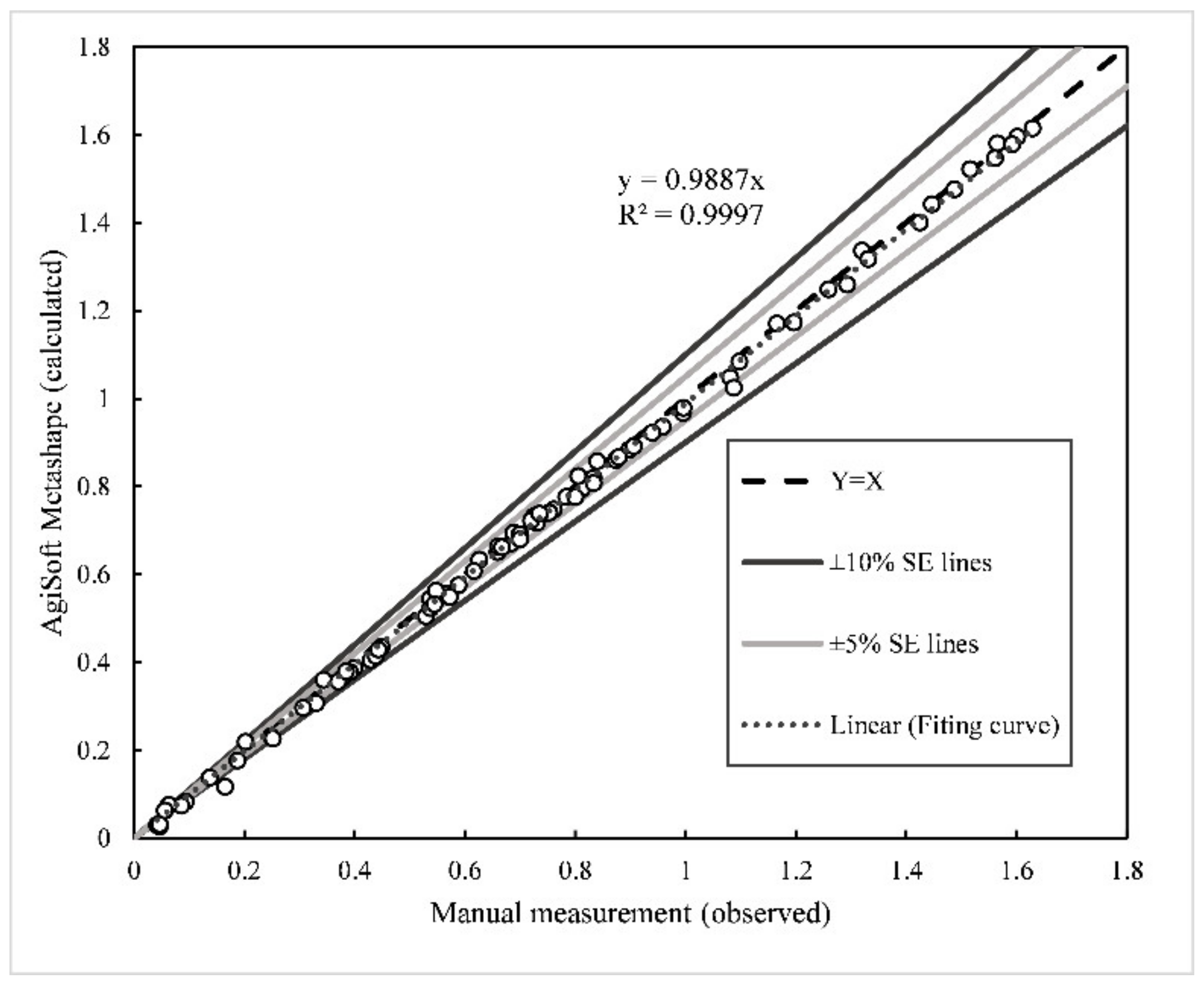
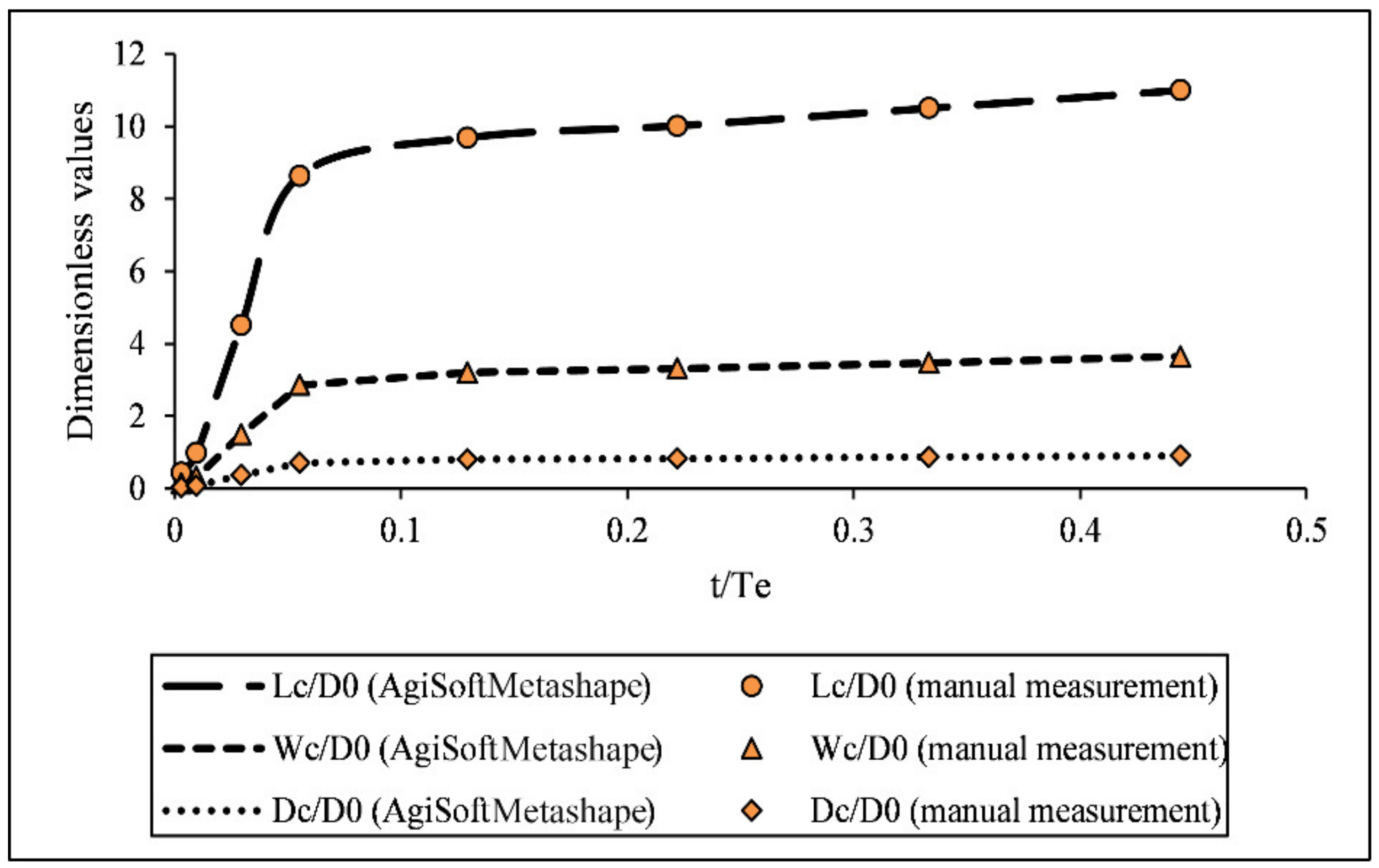
| MCP | X (m) | Y (m) | Z (m) | EX (m) | EY (m) | EZ (m) | (EX)2 | (EY)2 | (EZ)2 | RMSE (m) |
|---|---|---|---|---|---|---|---|---|---|---|
| L1 | 1.25 | 0.11 | 0 | 1.93 × 10−3 | 3.10 × 10−4 | 2.60 × 10−4 | 3.71 × 10−6 | 9.61 × 10−8 | 6.76 × 10−8 | 1.97 × 10−3 |
| L2 | 1.25 | 0.33 | 0 | 1.55 × 10−3 | 5.60 × 10−4 | 2.10 × 10−4 | 2.40 × 10−6 | 3.14 × 10−7 | 4.41 × 10−8 | 1.66 × 10−3 |
| L3 | 1.25 | 0.55 | 0 | 3.85 × 10−3 | 2.20 × 10−4 | 1.85 × 10−3 | 1.48 × 10−5 | 4.84 × 10−8 | 3.42 × 10−6 | 4.28 × 10−3 |
| L4 | 1.25 | 0.77 | 0 | 1.00 × 10−3 | 1.65 × 10−3 | 8.20 × 10−4 | 1.00 × 10−6 | 2.72 × 10−6 | 6.72 × 10−7 | 2.10 × 10−3 |
| R1 | −1.25 | 0.11 | 0 | 5.50 × 10−4 | 8.20 × 10−4 | 1.60 × 10−3 | 3.03 × 10−7 | 6.72 × 10−7 | 2.56 × 10−6 | 1.88 × 10−3 |
| R2 | −1.25 | 0.33 | 0 | 2.00 × 10−4 | 1.10 × 10−3 | 9.50 × 10−4 | 4.00 × 10−8 | 1.21 × 10−6 | 9.03 × 10−7 | 1.47 × 10−3 |
| R3 | −1.25 | 0.55 | 0 | 1.55 × 10−3 | 1.55 × 10−3 | 1.71 × 10−3 | 2.40 × 10−6 | 2.40 × 10−6 | 2.92 × 10−6 | 2.78 × 10−3 |
| R4 | −1.25 | 0.77 | 0 | 1.80 × 10−3 | 2.50 × 10−4 | 1.23 × 10−3 | 3.24 × 10−6 | 6.25 × 10−8 | 1.51 × 10−6 | 2.19 × 10−3 |
| C1 | 0 | 0 | 0 | 8.50 × 10−4 | 9.60 × 10−4 | 1.95 × 10−3 | 7.23 × 10−7 | 9.22 × 10−7 | 3.80 × 10−6 | 2.33 × 10−3 |
| C2 | 0 | 0 | −0.11 | 5.50 × 10−4 | 1.65 × 10−3 | 8.58 × 10−4 | 3.03 × 10−7 | 2.72 × 10−6 | 7.36 × 10−7 | 1.94 × 10−3 |
| 2.26 × 10−3 |
| Test No. | Name | Qo (L/s) | Hs (cm) | Test No. | Name | Qo (L/s) | Hs (cm) | Test No. | Name | Qo (L/s) | Hs (cm) |
|---|---|---|---|---|---|---|---|---|---|---|---|
| 1 | a1,1 | 12.5 | 39.5 | 16 | a1,2 | 12.5 | 45 | 31 | a1,3 | 12.5 | 50.5 |
| 2 | b1,1 | 17 | b1,2 | 32 | b1,3 | ||||||
| 3 | c1,1 | 18 | c1,2 | 33 | c1,3 | ||||||
| 4 | d1,1 | 19 | d1,2 | 34 | d1,3 | ||||||
| 5 | e1,1 | 20 | e1,2 | 35 | e1,3 | ||||||
| 6 | a2,1 | 15 | 21 | a2,2 | 15 | 36 | a2,3 | 15 | |||
| 7 | b2,1 | 22 | b2,2 | 37 | b2,3 | ||||||
| 8 | c2,1 | 23 | c2,2 | 38 | c2,3 | ||||||
| 9 | d2,1 | 24 | d2,2 | 39 | d2,3 | ||||||
| 10 | e2,1 | 25 | e2,2 | 40 | e2,3 | ||||||
| 11 | a3,1 | 18 | 26 | a3,2 | 18 | 41 | a3,3 | 18 | |||
| 12 | b3,1 | 27 | b3,2 | 42 | b3,3 | ||||||
| 13 | c3,1 | 28 | c3,2 | 43 | c3,3 | ||||||
| 14 | d3,1 | 29 | d3,2 | 44 | d3,3 | ||||||
| 15 | e3,1 | 30 | e3,2 | 45 | e3,3 |
| Range (m) | DPI-8 Handheld Scanner | SFM | ||
|---|---|---|---|---|
| Typical Accuracy (RMSE) | Minimum Accuracy | Typical Accuracy (RMSE) | Minimum Accuracy | |
| <1 | 0.20% | 0.5% | 0.26% | 0.51% |
| 1–2 | 0.50% | 0.8% | 0.31% | 0.58% |
| SFM Model | Purpose | Error Rate (mm) | R2 (Dimensionless) |
|---|---|---|---|
| Ruther (2019) [11] | Determining the bed in a physical fluvial model | 0.05–2.96 | 0.9965 |
| Zamani et al. (2019) [29] | Determining the bed surface particles sizes | 0.67–1.1 | 0.98 |
| The current study | Determining the sediment flushing cone dimensions | 0.03–0.74 | 0.9997 |
Publisher’s Note: MDPI stays neutral with regard to jurisdictional claims in published maps and institutional affiliations. |
© 2022 by the authors. Licensee MDPI, Basel, Switzerland. This article is an open access article distributed under the terms and conditions of the Creative Commons Attribution (CC BY) license (https://creativecommons.org/licenses/by/4.0/).
Share and Cite
Haghjouei, H.; Kantoush, S.A.; Beiramipour, S.; Rahimpour, M.; Qaderi, K. Experimental Study Demonstrating a Cost-Effective Approach for Generating 3D-Enhanced Models of Sediment Flushing Cones Using Model-Based SFM Photogrammetry. Water 2022, 14, 1588. https://doi.org/10.3390/w14101588
Haghjouei H, Kantoush SA, Beiramipour S, Rahimpour M, Qaderi K. Experimental Study Demonstrating a Cost-Effective Approach for Generating 3D-Enhanced Models of Sediment Flushing Cones Using Model-Based SFM Photogrammetry. Water. 2022; 14(10):1588. https://doi.org/10.3390/w14101588
Chicago/Turabian StyleHaghjouei, Hadi, Sameh A. Kantoush, Sepideh Beiramipour, Majid Rahimpour, and Kourosh Qaderi. 2022. "Experimental Study Demonstrating a Cost-Effective Approach for Generating 3D-Enhanced Models of Sediment Flushing Cones Using Model-Based SFM Photogrammetry" Water 14, no. 10: 1588. https://doi.org/10.3390/w14101588
APA StyleHaghjouei, H., Kantoush, S. A., Beiramipour, S., Rahimpour, M., & Qaderi, K. (2022). Experimental Study Demonstrating a Cost-Effective Approach for Generating 3D-Enhanced Models of Sediment Flushing Cones Using Model-Based SFM Photogrammetry. Water, 14(10), 1588. https://doi.org/10.3390/w14101588









